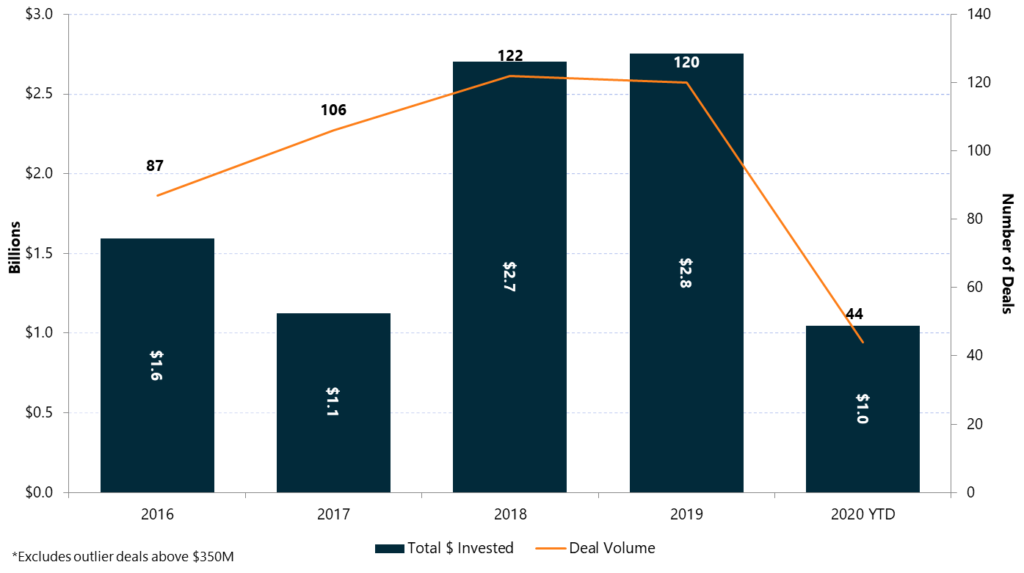Online Grocery Retail: The Impact of a Surge on the Supply Chain
It’s no surprise that online food sales are surging in the wake of Covid-19. While exact figures are changing all the time as methods to control the epidemic are rolled out, one thing is for certain; we have drastically altered our food shopping habits. A recent study claims that online grocery shopping in the US has jumped from 3%-4% to 10-%15% over the last two months. This level of online grocery retailing is on par with South Korea and China, the markets that led the world in online grocery pre-COVID with, respectively, 19% and 14% of all food retail done online. In February, Nielsen’s updated model valued online food and beverage sales at $143 billion by 2025 based on a 30% share. With 42% of the growth required to hit this 2025 target occurring in just under three months, the majority of the new online shopping traffic is expected to stick after COVID restrictions are lifted.
Business Models
Products originally destined for the restaurant industry are now aimed at new customers. Impossible Foods has shifted its original focus from restaurant and fast-food markets to grocery shelves, where its burgers must compete with rival Beyond Meat’s consumer packaged goods (CPG) products. You can now buy Impossible Burgers in 1,700 Kroger stores across the US.
Direct-to-consumer (D2C) models are appearing everywhere but customer acquisition is still difficult and expensive. Pivots to D2C have come from companies ranging from Calyxt, which offers a new cooking oil with reduced sat fat, to individual farmers such as White Oak Pastures which has turned to online deliveries as local customers look for new ways to buy their favorite local produce. Even industry incumbents such as Heinz have set up direct sales channels.
Even consumers who have decided to stick with brick and mortar retailers are increasingly paying someone else to shop for them. Instacart, a provider of a service to deliver groceries from local stores, hired 300,000 shoppers in April and is looking to add 250,000 more in May. The company is now reporting it will turn a profit for the first quarter in its history.
While software as a service (SaaS) platforms such as Shopify can help setup D2C sales channels online, backend processes will need to adapt. US-based Takeoff Technologies offers an automated grocery fulfillment solution that lets retailers bolt D2C order fulfilment centers onto an existing logistics infrastructure. Another German-based provider, Fliit, specializes in a platform that connects fresh food shippers with transportation solutions all in one place. The company offers the platform that is needed once Takeoff Technologies has fulfilled the order in-store. Early customers for Fliit include HelloFresh and Marley Spoon.

Competition
As we discussed at a recent Cleantech Group Power Breakfast on Local Food Networks, if this is just a logistics challenge, then Amazon should be crushing start-ups. The task for a company in online food retail, such as Imperfect Foods, is to provide a unique experience to the customer because food is such a personal item. One solution is to control your own delivery. Imperfect Foods gets two chances to interact with its customer – at sale and delivery – and so it has control over the experience in both situations. COVID will likely be an acid test for customer service as the company pushes its delivery capacity to the maximum.
For incumbents, increasing resilience in their supply chain is the priority. This will see greater investment in warehousing innovations and capacity, cold chain logistics and other supply chain steps. Supply chain tracking, either through blockchain (Ripe.IO) or freshness monitoring (Strella Biotechnology), will be critical to understanding where supply chains are most vulnerable. This will require automation of the analogue parts of the food chain, such as quality inspection (ImpactVision), safety testing (Clear Labs) and many other steps. As the processing stages of the food chain are often the most labor-intensive, increasing investment in automation tools is expected while social distancing and food safety concerns persist into the near future.
Keep an eye on…
In China, online grocery retailers are approaching farmers and involving them in creating more personable online content to promote their products, an idea that is proving to be very popular.. Online retailers such as JD.com and Taobao are hosting platforms where farmers can livestream a more human, personal look into their farms to help market their product. This has shown early signs of being very profitable for the farmers who have been looking for ways to engage their customer directly. Taobao is aiming to generate $2.1 billion in agricultural sales this year using the new platform.


